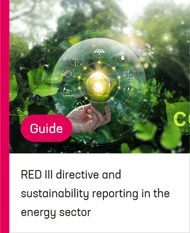Expert guide for RED III directive and sustainability reporting in the energy sector
This guide is about the requirements set by the EU’s new sustainability reporting obligations for operators in the energy sector. The criteria are aimed at safeguarding sustainable development and environmental diversity. The sustainability reporting requirement comes from the EU RED III directive, published in November 2023, which will gradually expand its scope.
In the future, more attention will be paid to the sources of materials used in the generation of energy and to the environmental impacts of both production and transports. The EU’s new Renewable Energy Directive, also known as the RED III directive, will guide the national legislation of the Member States in a more environmentally conscious direction.
This creates a novel challenge for operators: the environmental impacts of operations must be reported more precisely than before. The RED III directive imposes a sustainability reporting obligation on energy operators, which will apply to a larger number of plants obliged to demonstrate the sustainability of biomass.
Although sustainability reporting can in principle be done using spreadsheets, in practice the easiest and most reliable way is to automate supply chain reporting with a dedicated application.
In this RED III and sustainability reporting guide we answer e.g. the following points:
- Content of the sustainability reporting obligation
- Who is subject to the obligations
- The dual challenge for sustainability reporting
- Options for performing sustainability reporting

Download the guide by filling out the form. The guide is free of charge and downloading does not bind you to anything.